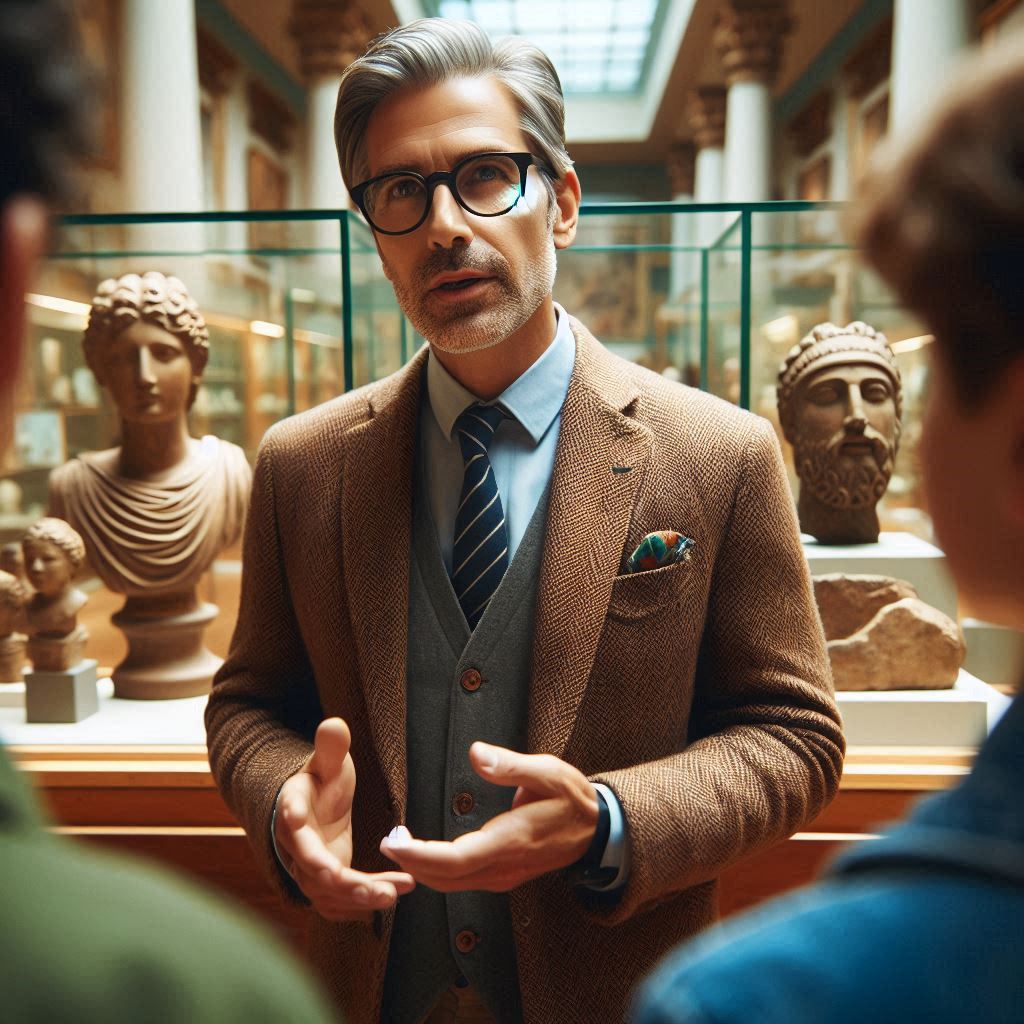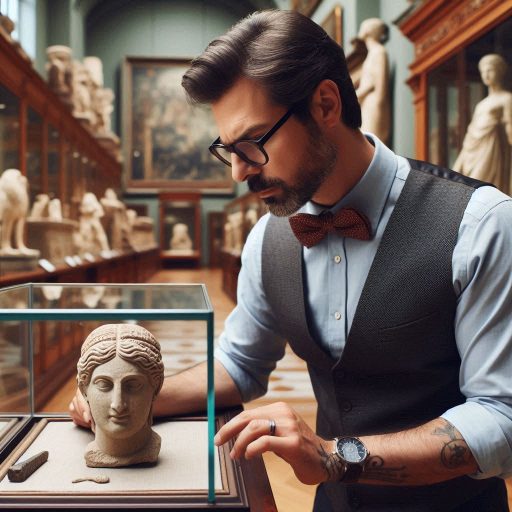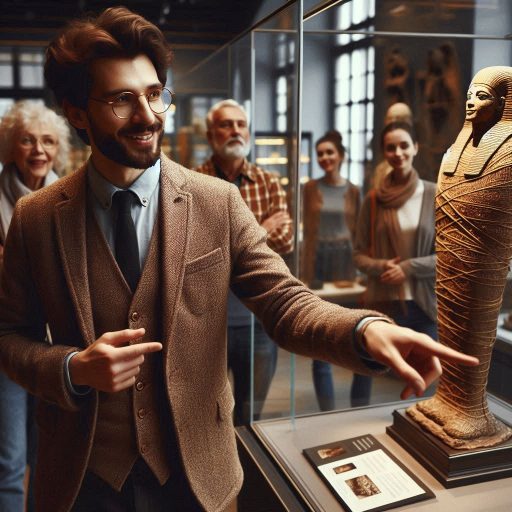Introduction
An art gallery curator manages an art collection within a gallery or museum as Art Gallery Curator Job and Duties.
They select, organize, and oversee exhibitions that showcase artworks.
Curators also research and interpret art pieces to provide context for viewers.
Their role is crucial in shaping how audiences experience and understand art.
They act as intermediaries between artists and the public, promoting artistic engagement.
Art gallery curators ensure that exhibitions are both educational and visually appealing.
They collaborate with artists, collectors, and other professionals to develop programs that enhance the gallery’s mission.
Curators also conduct outreach and community engagement initiatives to attract diverse audiences.
Their work helps foster a deeper appreciation for the arts.
The job description of an art gallery curator includes administrative tasks such as budgeting and grant writing.
Curators create exhibition catalogs and develop marketing materials to promote shows.
They also oversee the installation and de-installation of exhibitions, ensuring artworks are displayed safely.
Curators may conduct guided tours and educational workshops to enrich visitor experiences.
They play a vital role in preserving and presenting art, making it accessible to the public.
Education and Qualifications
Becoming an art gallery curator requires specific educational qualifications and skills.
This section explores the necessary education, certifications, and qualities essential for success in this role.
Required Education Level
Most art gallery curators hold a bachelor’s degree in art history, fine arts, or a related field.
This educational background provides foundational knowledge about various art movements and techniques.
Courses often include topics like art theory, museum studies, and critical analysis.
Many universities also offer specialized programs that focus on curatorial practices.
These programs teach students how to develop and manage exhibitions effectively.
In addition to a bachelor’s degree, some curators pursue a master’s degree in art history or museum studies.
This advanced education allows them to deepen their understanding of art and enhance their curatorial skills.
A master’s degree often makes candidates more competitive in the job market.
It can also open doors to higher-level positions within art institutions.
Additional Certifications and Specialized Training
While a bachelor’s or master’s degree is essential, additional certifications can enhance a curator’s qualifications.
Many professional organizations offer certifications in museum studies and curatorial practices.
These programs provide valuable knowledge and skills that benefit curators in their roles.
Specialized training in areas such as conservation, exhibition design, or educational programming can also be advantageous.
These skills allow curators to manage different aspects of an art gallery effectively.
Workshops and internships with established curators can provide hands-on experience and networking opportunities.
Skills and Qualities Needed for the Job
Successful art gallery curators possess a unique blend of skills and qualities.
One of the most critical skills is attention to detail.
Curators must ensure that every aspect of an exhibition is carefully planned and executed.
This attention to detail affects the overall presentation and audience experience.
Strong communication skills are also vital for curators.
They often collaborate with artists, collectors, and other professionals.
Effective communication helps in articulating their vision for exhibitions and fostering teamwork.
Additionally, curators need excellent organizational skills.
They manage multiple projects simultaneously, requiring efficient time management.
They must keep track of deadlines and budgets while coordinating with various stakeholders.
Creativity is another essential quality for art curators.
They must develop innovative exhibition concepts that engage the audience.
Curators often think outside the box to create meaningful connections between artworks.
A passion for art and a deep understanding of art history further enhance a curator’s effectiveness.
This passion drives them to promote artists and educate the public about art.
Adaptability is crucial in this fast-paced field.
Art galleries often face unexpected challenges, such as changes in funding or audience interest.
Curators who can adapt quickly will thrive in this dynamic environment.
Becoming an art gallery curator involves specific educational qualifications, certifications, and a diverse skill set.
A bachelor’s degree in art history or a related field is typically required.
Additional certifications and specialized training can further enhance a curator’s credentials.
A successful curator combines passion for art with essential skills and qualities.
Read: Best Tools and Software for Character Designers
Responsibilities of an Art Gallery Curator
Selecting and Acquiring Artwork for the Gallery’s Collection
An art gallery curator plays a crucial role in selecting and acquiring artwork.
They evaluate various pieces to ensure quality and relevance.
Curators research emerging and established artists for potential acquisitions.
They attend art fairs, exhibitions, and studio visits to discover new works.
By building relationships with artists, curators can access unique pieces for their galleries.
They also negotiate prices and terms of sale.
The curator must consider the gallery’s mission and audience when making decisions.
They aim to create a diverse and engaging collection that resonates with visitors.
Planning and Organizing Art Exhibitions
Planning and organizing art exhibitions is a key duty for curators.
They conceptualize themes that align with the gallery’s vision.
Curators coordinate logistics, such as space allocation and installation timelines.
They create exhibition schedules that include opening dates and duration.
Curators also develop layout plans to enhance visitor experience.
They consider the flow of the exhibition and the positioning of each artwork.
Promoting exhibitions through marketing strategies also falls within their responsibilities.
Curators may organize opening receptions and educational programs related to the exhibitions.
Researching and Writing About Art
Researching and writing about art is essential for curators.
They gather information on artists, movements, and historical contexts.
This research informs their exhibition themes and artwork selection.
Curators produce exhibition catalogs that provide insights into featured works.
These catalogs often include artist biographies, critical essays, and artwork descriptions.
Writing for various platforms, such as websites and social media, also enhances the gallery’s visibility.
Curators must articulate their vision clearly to engage and educate the audience.
Their written work contributes to the overall appreciation of the artwork.
Collaborating with Artists, Galleries, and Other Institutions
Collaboration is vital for an art gallery curator’s success.
They work closely with artists to understand their intentions and visions.
By fostering relationships, curators facilitate future exhibitions and projects.
They also connect with other galleries and institutions for joint ventures.
Collaborative exhibitions can broaden the audience and enhance reputations.
Curators may partner with educational institutions for workshops and lectures.
These collaborations create a vibrant community around the gallery and its artists.
Curators often attend networking events to expand their professional connections.
Managing the Gallery’s Budget and Finances
Managing the gallery’s budget and finances is a critical responsibility.
Curators work with financial teams to establish budgets for exhibitions.
They monitor spending and ensure all costs align with financial projections.
Curators seek funding through grants, sponsorships, and donations.
They must balance artistic vision with financial sustainability.
Maintaining accurate financial records is essential for transparency and accountability.
Curators also analyze financial reports to inform future decisions.
A strong understanding of budgeting helps curators maximize resources and support their artistic goals.
Art gallery curators play a multifaceted role.
They select and acquire artwork, organize exhibitions, research art, collaborate with stakeholders, and manage finances.
Each responsibility contributes to the gallery’s success and enriches the cultural landscape.
Read: Ceramic Art: From Hobby to Professional Career
Day-to-Day Duties
Meeting with Artists to Discuss Their Work
An art gallery curator regularly meets with artists to explore their creations.
These discussions help curators understand the artist’s vision and intent.
Curators provide valuable feedback to artists, enhancing their work’s presentation.
They engage in thoughtful dialogue about artistic techniques and concepts.
This interaction fosters strong relationships with the artistic community.
It also keeps curators informed about emerging trends in the art world.
Curators use these insights to shape future exhibitions.
By prioritizing artist meetings, curators cultivate a supportive environment for creativity.
This practice enriches the gallery’s offerings and attracts diverse audiences.
Coordinating with Other Staff Members to Plan Exhibitions
Effective communication among gallery staff is crucial for successful exhibitions.
Curators collaborate with various departments to ensure a cohesive approach.
They work closely with marketing teams to promote upcoming shows.
Coordinators manage logistics, from installation schedules to event planning.
This teamwork ensures that exhibitions run smoothly and efficiently.
Curators hold regular meetings with their teams to discuss progress.
They assign tasks based on each member’s strengths and expertise.
This collaborative process leads to innovative ideas and fresh perspectives.
By coordinating effectively, curators create engaging exhibitions that resonate with visitors.
Their leadership sets the tone for a productive gallery environment.
Conducting Research on Artists and Art Movements
Research is a fundamental duty for art gallery curators.
They stay informed about current art movements and historical contexts.
Curators explore various resources, including books, articles, and online databases.
They analyze trends and assess their impact on contemporary art.
This research informs exhibition themes and artist selections.
Curators also investigate artists’ backgrounds and influences to provide context for their work.
This knowledge enhances visitor understanding and appreciation of the art.
By conducting thorough research, curators develop engaging narratives for exhibitions.
They can effectively communicate the significance of each piece.
This dedication to research enriches the gallery experience for all attendees.
Handling Administrative Tasks Such as Organizing Shipping and Logistics for Artwork
In addition to creative duties, art gallery curators manage essential administrative tasks.
They coordinate shipping and logistics for incoming and outgoing artwork.
Curators ensure that artworks arrive safely and on time.
They liaise with shipping companies and oversee packing processes.
This attention to detail safeguards the integrity of the pieces.
Curators also manage budgets for exhibitions and related activities.
They track expenses and ensure adherence to financial constraints.
Proper record-keeping is vital for accountability and planning.
Curators maintain accurate inventory lists of artworks in the gallery.
By handling these administrative duties, they create a stable foundation for successful exhibitions.
The daily responsibilities of an art gallery curator encompass various essential tasks.
From engaging with artists to coordinating staff, each duty contributes to the gallery’s success.
By conducting research and managing logistics, curators ensure that exhibitions thrive.
Their multifaceted role enhances the overall art experience for both artists and visitors.
Read: How to Create Memorable Characters: Pro Tips

Exhibition-Related Tasks
Art gallery curators play a crucial role in shaping the visitor experience.
They manage various exhibition-related tasks, including developing themes, designing layouts, writing descriptions, and collaborating with designers.
Each of these tasks contributes significantly to the success of an exhibition.
Transform Your Career Today
Unlock a personalized career strategy that drives real results. Get tailored advice and a roadmap designed just for you.
Start NowDeveloping Themes for Exhibitions
The curator begins the exhibition process by developing a compelling theme.
This theme unifies the selected artworks and engages visitors.
Curators research trends, historical contexts, and artists’ intentions.
They often brainstorm ideas that resonate with current social issues or cultural movements.
This creative process allows curators to craft narratives around the artworks.
A well-defined theme sets the stage for an engaging and thought-provoking exhibition.
Once the theme is established, the curator selects artworks that align with the concept.
They consider various mediums, styles, and artists to create a balanced collection.
This selection process involves extensive discussions with artists and other stakeholders.
Curators ensure that the chosen pieces reflect the exhibition’s theme while maintaining diversity.
The goal is to create a cohesive experience that captivates and informs visitors.
Designing Exhibition Layouts
After developing the theme, curators focus on designing the exhibition layout.
This task involves careful planning of how artworks will be displayed.
Curators consider factors like flow, sightlines, and spatial relationships.
A well-designed layout enhances the viewer’s experience and encourages engagement.
Curators often sketch preliminary layouts to visualize the exhibition space.
They assess how different artworks interact within the physical environment.
Curators also consider accessibility and visitor comfort.
They ensure that pathways are clear and artworks are easy to view.
This planning stage often involves consulting with museum staff and other experts.
By collaborating with these professionals, curators create a layout that meets both artistic and practical needs.
Writing Labels and Descriptions for Artwork
Curators are responsible for writing labels and descriptions for the artwork.
These texts provide essential information to visitors, enriching their understanding.
Curators ensure that each label includes the artist’s name, title, medium, and date.
They also offer contextual information that enhances the viewer’s experience.
This may include details about the artist’s background, the inspiration behind the work, or the historical context.
Writing in an engaging and accessible manner is crucial.
Curators strive to balance scholarly information with approachable language.
This approach ensures that all visitors, regardless of their art knowledge, can connect with the exhibition.
Well-crafted labels guide visitors through the exhibition and invite them to engage with the artworks.
Collaborating with Designers and Installers
Successful exhibitions require collaboration with designers and installers.
Curators work closely with these professionals to ensure their vision is realized.
Designers bring expertise in aesthetics and spatial design.
They help transform the curator’s concepts into tangible exhibition elements.
Installers play a vital role in setting up the exhibition.
They carefully handle artworks, ensuring each piece is displayed correctly.
Curators communicate their layout plans and vision to both designers and installers.
This collaboration ensures that the exhibition aligns with the original concept.
Regular meetings and discussions facilitate a smooth installation process.
Exhibition-related tasks encompass a wide range of responsibilities for art gallery curators.
From developing themes to collaborating with designers, each task is integral to creating impactful exhibitions.
Curators enhance the visitor experience through their expertise, creativity, and dedication to the arts.
Read: Ceramic Art Exhibitions to Visit in 2024
Networking and Outreach
Art gallery curators play a crucial role in networking and outreach.
They attend various art events and openings.
These gatherings provide opportunities to connect with artists, collectors, and other industry professionals.
Curators represent the gallery at art fairs and conferences.
This presence helps promote the gallery and its exhibitions.
Attending Art Events and Openings
Curators regularly attend art events and openings to immerse themselves in the artistic community.
They observe current trends and engage with emerging artists.
By participating in these events, curators gain insights into the evolving art landscape.
They also identify potential artists for future exhibitions.
Building a strong presence at these events fosters relationships within the art community.
Building Relationships with Artists, Collectors, and Other Industry Professionals
Developing relationships with artists is vital for a curator’s success.
These connections lead to opportunities for collaboration and unique exhibitions.
Curators often meet artists at openings and studio visits.
They discuss ideas and explore themes that resonate with both the artists and the gallery’s mission.
Collectors also play a significant role in a curator’s outreach efforts.
Establishing rapport with collectors opens doors for future partnerships.
Curators invite collectors to exclusive events and previews, creating a sense of belonging.
Engaging collectors not only strengthens ties but also encourages them to support the gallery.
Networking with other industry professionals is equally important.
Curators connect with gallery owners, museum directors, and art critics.
These relationships facilitate knowledge sharing and collaboration on projects.
They provide valuable insights into best practices in the art world.
Representing the Gallery at Art Fairs and Conferences
Art fairs and conferences are essential platforms for curators to represent their galleries.
Curators showcase their exhibitions and connect with a diverse audience.
They network with other galleries, artists, and collectors during these events.
This visibility enhances the gallery’s reputation and outreach efforts.
Curators often participate in panel discussions and workshops at conferences.
These opportunities allow them to share their expertise and insights.
Engaging with a wider audience helps promote the gallery’s mission and exhibitions.
Curators can showcase their innovative approaches and share success stories.
This representation helps position the gallery as a thought leader in the industry.
Promoting the Gallery and Its Exhibitions Through Various Channels
Curators actively promote the gallery and its exhibitions through various channels.
They utilize social media platforms to reach a broader audience.
By sharing exhibition highlights, behind-the-scenes content, and artist interviews, curators generate excitement.
These strategies encourage followers to engage with the gallery both online and offline.
Email newsletters also serve as a valuable tool for promoting exhibitions.
Curators send updates about upcoming shows, events, and artist features.
This direct communication keeps the audience informed and engaged.
It fosters a sense of community around the gallery.
Networking and outreach are vital components of a curator’s role.
By attending art events, building relationships, and representing the gallery at fairs, curators enhance their gallery’s visibility.
They leverage various channels to promote exhibitions and engage with the art community.
Through these efforts, curators ensure the success of their galleries and the artists they support.
Challenges and Rewards of the Job
Being an art gallery curator comes with a unique set of challenges and rewards.
This role requires a delicate balance between creativity and administrative tasks.
Below, we explore some of the main challenges and rewards that curators face daily.
Dealing with Budget Constraints and Limited Resources
One significant challenge curators encounter is managing budget constraints.
Many galleries operate with tight financial limits.
This constraint forces curators to make tough choices about exhibitions.
They often need to prioritize which artists and artworks to showcase.
Limited resources also affect marketing and promotion.
Curators must find innovative ways to attract visitors on a shoestring budget.
This can lead to creative solutions that benefit the gallery.
However, it can also be a source of stress, as they seek funding and sponsorships.
Curators must stay resourceful and strategic to achieve their goals.
Balancing Creative and Administrative Aspects
Another challenge involves balancing creative and administrative duties.
Curators are often passionate about art and creativity.
Yet, they also face significant administrative responsibilities.
They must organize exhibitions, manage budgets, and coordinate logistics.
This duality can create tension between artistic vision and practical execution.
Curators must remain organized and efficient in their administrative tasks.
They often juggle multiple projects simultaneously.
Time management becomes crucial to ensure that both creative and administrative duties receive attention.
Successful curators find ways to integrate these aspects harmoniously.
They create a workflow that allows for creative expression while meeting organizational needs.
Satisfaction of Curating Successful Exhibitions
Despite the challenges, curating successful exhibitions brings immense satisfaction.
When a curator successfully showcases an important artwork, it feels rewarding.
They experience joy in sharing meaningful art with the public.
This satisfaction grows when exhibitions resonate with visitors.
Positive feedback and high attendance can validate a curator’s hard work.
Each successful exhibition enhances their reputation and strengthens their professional network.
Celebrating these successes becomes a motivating factor in their careers.
Curators take pride in creating spaces that inspire and provoke thought.
Opportunities for Professional Growth and Advancement in the Art world
Curators also enjoy opportunities for professional growth and advancement in the art world.
The art industry is dynamic and ever-changing.
As curators gain experience, they can take on more significant responsibilities.
They may have the chance to curate larger exhibitions or work with prestigious institutions.
Networking plays a vital role in this growth.
Collaborating with artists, collectors, and other curators opens doors to new opportunities.
Continuing education and attending art fairs help them stay updated on trends.
This ongoing learning fosters personal and professional development.
The role of an art gallery curator is both challenging and rewarding.
They navigate budget constraints while balancing creativity with administrative tasks.
The satisfaction of curating successful exhibitions fuels their passion for art.
Moreover, the opportunities for growth in the art world make this career path enticing.
Curators play a crucial role in the cultural landscape, and their dedication enriches communities through art.
Conclusion
An art gallery curator plays a crucial role in managing and organizing art exhibitions.
They are responsible for acquiring, researching, and displaying artwork in a gallery.
Curators need to have a deep knowledge of art history and trends in the art world to make informed decisions about which pieces to showcase.
Additionally, they collaborate with artists, collectors, and other institutions to build relationships and bring in new pieces for exhibitions.
Art gallery curators also have a responsibility to preserve and promote art for future generations.
They ensure that artworks are properly cared for and stored to maintain their quality and integrity.
Curators coordinate educational programs and events to engage the public with art and foster a deeper appreciation for artistic expression.
By curating exhibitions that resonate with diverse audiences, they contribute to the cultural enrichment of society.
If you are passionate about art and enjoy working with artists and art enthusiasts, a career as an art gallery curator may be a rewarding path for you.
This role allows you to immerse yourself in the world of art, share your knowledge and expertise with others, and make a meaningful impact on the art community.
Aspiring curators can explore many career opportunities in museums, galleries, and cultural institutions.
They can preserve and promote art for future generations.




